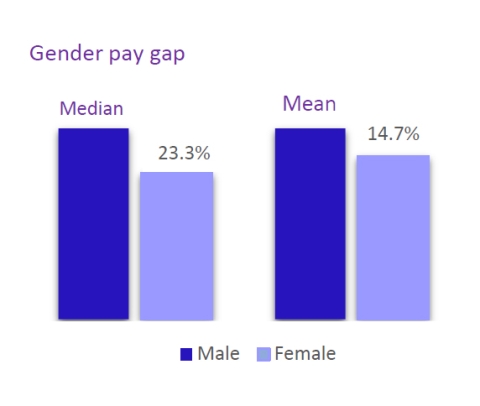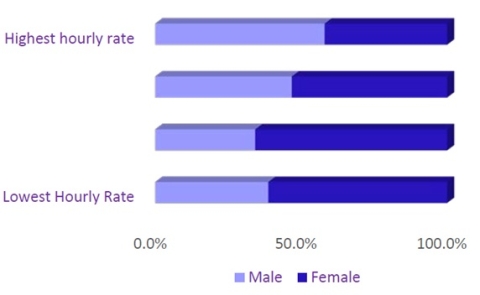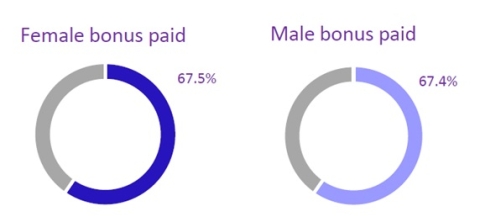Our gender pay gap figures
The gender pay gap shows the difference between the average (mean and median) earnings of men and women and is expressed as a percentage of men’s earnings.
A gender pay gap above zero will show that, on average, men earn more. Complying with statutory calculations, the University has identified its gender pay gap in relation to the:
- mean and median difference between hourly rates for males and females
- the mean and median difference between bonus pay for males and females
- the proportions of male and female employees who were paid bonus pay
- the proportions of male and female employees in each pay band quartile
Mean and median pay gap

The mean pay gap is the difference between the average hourly rate of pay between males and females, while the median pay gap is the difference between the middle point of average hourly rates (when listed in numerical order) of pay for males compared to the middle point for females.
Our mean pay gap is 14.7%, which is lower than the wider economy (17.4%*) and lower than the higher education (HE) sector (15.5%*). By our internal measurements, the mean pay gap has been steadily reducing since 2005.
The University's median pay gap is 23.3%, which is higher than the wider economy (18.4%*) and higher than the higher education (HE) sector (14.3%*). This is largely due to the significantly higher proportion of female staff within support services at the lower grades within our pay structure.
* Source: ONS 2016–17

Gender bonus gap
Bonuses paid within the University consist of:
- Recognition Awards, paid to individuals and teams who have excelled in their performance
- The allocation of vouchers to staff as a token of thanks for their contribution throughout the year
The mean bonus gender pay gap shows the difference between the average bonus pay received by male and female staff. The mean bonus gender pay gap for University staff is -0.5%. The University’s median gender bonus gap is 0%.
Proportion of male and female staff receiving a bonus
The proportion of colleagues across the University who received a bonus under the statutory definition was virtually identical.

Proportion of male and female staff in each pay quartile
The University has identified the percentage of female and male staff in each of 4 pay quartiles, by dividing the workforce into 4 equal parts.
Female colleagues account for 61.3% of the lowest quartile and 65.8% of the lower-middle quartile. The upper-middle quartile is more balanced, with female staff making up 53.2% of this group. In the upper quartile, the split between female and male is 42% female and 58% male.
Why we have a gender pay gap
A major contributing factor to our gender pay gap is the higher proportion of females in the lower 2 pay quartiles, undertaking roles such as administrative and catering roles which traditionally have attracted female applicants. These roles have also tended to provide flexibility around part time working which is attractive to those with caring responsibilities.
Another contributing factor to our pay gap is the higher proportion of males in senior academic roles. This is not only a concern for the University but an issue across the higher education sector.
We need to increase the number of women in leadership positions across the University, particularly in academic roles. We also need to ensure that roles at all levels attract a diverse pool of applicants.
The University recognises that many challenges remain and we are determined to take action to ensure that our day to day practice reflects the quality of our policy commitments.
How we're addressing the gender pay gap
Equality and inclusion is integral to the University’s People Strategy and the University is committed to deliver against its ambitions as outlined in this Strategy.
Athena SWAN action plan
We are very proud to have achieved a Bronze Award for the Equality Challenge Unit (ECU) Athena SWAN Charter, in recognition for work undertaken to address gender equality in Science, Technology, Engineering and Mathematics (STEM) across the Institution.
We are committed to maintaining our Bronze Award under the new extended principles which support gender equality across all academic and professional areas. We have developed a comprehensive action plan to achieve this.
Recruitment and selection review
A wide-ranging strategic review of recruitment and selection approaches and methodologies used across the University is planned, to ensure that roles attract a diverse pool of applicants and that salaries on appointment within grade reflect the level of skills and knowledge.
Apprenticeship programme
A working group looking at how the University can develop its apprenticeship programme is being established, looking at how apprenticeship programmes can be used to support career development for existing and new staff.
Maternity and adoption leave review
The University’s maternity and adoption leave provision is currently being reviewed and enhanced and initiatives to raise staff awareness around flexible working and shared parental leave are also being considered.
Women's career development programmes
We have an ongoing commitment to Aurora and Springboard programmes which support women’s career development and promotion prospects. The Aurora Programme is run by the Leadership Foundation for Higher Education.
This programme is run by women for women and draws on successful women from higher education and other sectors as speakers and role models to share their experiences and knowledge about the world of work and career development.
The Springboard Programme is a three month personal and work development programme for women, not a management development programme, but designed to complement the Aurora Programme and help prepare women, where appropriate, to apply for future Aurora Programmes.
Coaching and mentoring scheme
We introduced a University-wide Coaching and Mentoring scheme, providing a supportive opportunity to aid staff in identifying and achieving career goals, explore ideas and facilitate learning, as well as promoting a culture of equality and diversity.
Performance and Development Review (PDR) pilot scheme
A revised online Performance and Development Review (PDR) scheme, linked to a new Career Development Framework, is currently being piloted with the intention of rolling this out across the University in 2018/19.
The Career Development Framework underpinning the PDR scheme helps staff to identify and build on strengths, explore opportunities within the University and identify how to access available resources.
Monitoring success
To monitor the success of these initiatives in reducing the University’s Gender Pay Gap, ongoing reporting and analysis will be undertaken and embedded into the University’s wider workforce reporting.
Statement
To comply with The Equality Act 2010 (Gender Pay Gap Information) Regulations 2017, the University is required to publish gender pay gap information every year for all staff employed on 31 March 2017 and annually thereafter.
Equality, diversity and inclusion underpins all our work and is central to what we are and what we do. Our commitment is not restricted to the minimum legal requirements of equalities legislation, as we aim to deliver best practice whenever possible.
The University of Portsmouth is a diverse, multicultural and international community, committed to working in an inclusive way, developing a workforce that reflects our student community, the City of Portsmouth and the region’s diversity.
We are determined to identify and remove any potential gender bias and to ensure that we have an inclusive culture that values all staff.
I confirm that the data published in this report is accurate and satisfies the requirements of the Equality Act 2010 (Gender Pay Gap Information) Regulations 2017.
Peter Brook
Director of Human Resources
